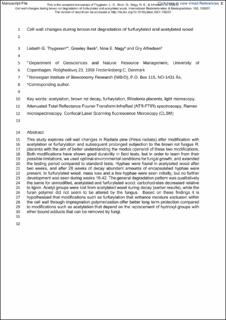| dc.contributor.author | Thygesen, Lisbeth G. | |
| dc.contributor.author | Beck, Greeley | |
| dc.contributor.author | Nagy, Nina Elisabeth | |
| dc.contributor.author | Alfredsen, Gry | |
| dc.date.accessioned | 2021-11-15T11:22:24Z | |
| dc.date.available | 2021-11-15T11:22:24Z | |
| dc.date.created | 2021-08-24T12:12:59Z | |
| dc.date.issued | 2021-05-30 | |
| dc.identifier.citation | Thygesen, L. G., Beck, G., Nagy, N. E., & Alfredsen, G. (2021). Cell wall changes during brown rot degradation of furfurylated and acetylated wood. International Biodeterioration & Biodegradation, 162, 105257. | en_US |
| dc.identifier.issn | 0964-8305 | |
| dc.identifier.uri | https://hdl.handle.net/11250/2829550 | |
| dc.description.abstract | This study explores cell wall changes in Radiata pine (Pinus radiata) after modification with acetylation or furfurylation and subsequent prolonged subjection to the brown rot fungus R. placenta with the aim of better understanding the modus operandi of these two modifications. Both modifications have shown good durability in field tests, but in order to learn from their possible limitations, we used optimal environmental conditions for fungal growth, and extended the testing period compared to standard tests. Hyphae were found in acetylated wood after two weeks, and after 28 weeks of decay abundant amounts of encapsulated hyphae were present. In furfurylated wood, mass loss and a few hyphae were seen initially, but no further development was seen during weeks 18–42. The general degradation pattern was qualitatively the same for unmodified, acetylated and furfurylated wood: carbohydrates decreased relative to lignin. Acetyl groups were lost from acetylated wood during decay (earlier results), while the furan polymer did not seem to be altered by the fungus. Based on these findings it is hypothesized that modifications such as furfurylation that enhance moisture exclusion within the cell wall through impregnation polymerization offer better long term protection compared to modifications such as acetylation that depend on the replacement of hydroxyl groups with ether bound adducts that can be removed by fungi. | en_US |
| dc.language.iso | eng | en_US |
| dc.publisher | Elsevier Ltd. | en_US |
| dc.rights | Attribution-NonCommercial-NoDerivatives 4.0 Internasjonal | * |
| dc.rights.uri | http://creativecommons.org/licenses/by-nc-nd/4.0/deed.no | * |
| dc.title | Cell wall changes during brown rot degradation of furfurylated and acetylated wood | en_US |
| dc.type | Peer reviewed | en_US |
| dc.type | Journal article | en_US |
| dc.description.version | acceptedVersion | en_US |
| dc.rights.holder | © 2021 Elsevier Ltd | en_US |
| dc.source.volume | 162 | en_US |
| dc.source.journal | International Biodeterioration & Biodegradation | en_US |
| dc.identifier.doi | 10.1016/j.ibiod.2021.105257 | |
| dc.identifier.cristin | 1928291 | |
| dc.relation.project | Norges forskningsråd: 297899 | en_US |
| dc.relation.project | Norges forskningsråd: 243663 | en_US |
| dc.source.articlenumber | 105257 | en_US |
| cristin.ispublished | true | |
| cristin.fulltext | postprint | |
| cristin.qualitycode | 1 | |

